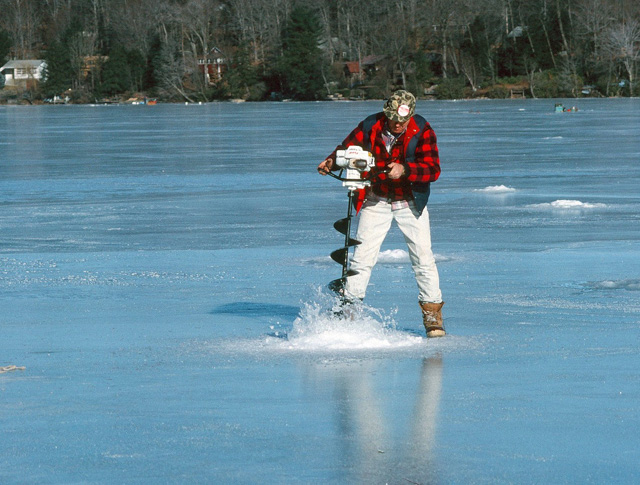How to Use an Ice Auger for Hard-Water Fishing
By Ken Schultz
Dec 11, 2019
Factors that affect how to use an ice auger, whether manual or powered, include your stance, blade size, blade sharpness, species pursued, and ice thickness.
If you’re just getting started in ice fishing you should know that it all starts with a hole in the ice, and that there are a number of ways to do that. I’ve cut ice holes with a spud, hand auger, gas auger, and chainsaw. In some northern environments, the latter is a good way to go, using a long-bladed saw on thick ice to cut large rectangular fishing holes. A spud can do the job on thin ice, but the thicker the ice the harder a spud is to use, plus you wind up with somewhat jagged sides and lots of pounding impact on wrists, arms, and shoulders.
Most ice anglers, and certainly avid ones, use an auger, either manual or powered, the latter being favored in northernmost lakes where ice can get very thick. Gas-driven augers are a mainstay, but battery-powered augers are also an option.
It doesn’t take long to learn how to use an ice auger, and the benefits of timely, numerous, and neat hole cutting are obvious.
General Usage
- If you’re new to ice fishing, the best way to learn how to how to use an ice auger (assuming that you don’t have an ice fishing pal or relative who has let you operate theirs) is to read the manual first, follow the instructions, and pay special attention to directions on how to stand while using an auger.
- Keep your feet shoulder-width apart, and stand tall, without excessively bending over.
- Good boot soles, and/or ice cleats or grippers, will help you stand firmly on the ice.
- Keep blades sharp, and have a spare set to use if the current ones become dull.
- Always cover the blade when an auger is not being used, and store it so that it does not lay on snow, which will freeze on the blade and make it less effective.
Manual Augers
- Use a blade size appropriate for your quarry. If that’s panfish and smallish trout, walleye, and pickerel, you’ll appreciate the easier use of a 6-inch blade over an 8-incher. If it’s just panfish, a 4-incher might do, and you’ll find it easier to use, plus you can drill more holes without fatigue.
- The number of holes you’re willing or able to drill will be determined by the blade size (more effort for larger blades) and the ice thickness (more effort for thicker ice).
- Your upper hand keeps the auger in place and should stay in place while your lower hand turns the blade. Avoid wide swaying.
- Line the auger up with the ice as vertically as possible to avoid cutting an angled hole.
Power Augers
- Power augers excel at cutting thick ice, making large holes (for bigger quarry), and making many holes. Since torque isn’t an issue with power augers as it is with manual ones, you can do more.
- Use a power auger if you want or need to move a lot. This is how you find fish, as opposed to drilling a hole and waiting for fish to find you.
- Overcoming wobble while you start a hole with a power auger can be a chore. What helps here are sharp blades, blade tips that bite into the ice quickly, and light weight.
- Power augers have a tendency to bring up a lot of slush and water after they punch through, so make sure you wear tall waterproof boots.
- In the beginning of the season, use fresh gas, preferably ethanol free, in a gas-powered auger, to minimize startup issues.
With these ice auger tips you’re ready to get started, assuming, of course, that you already have your fishing license.
.jpg)









